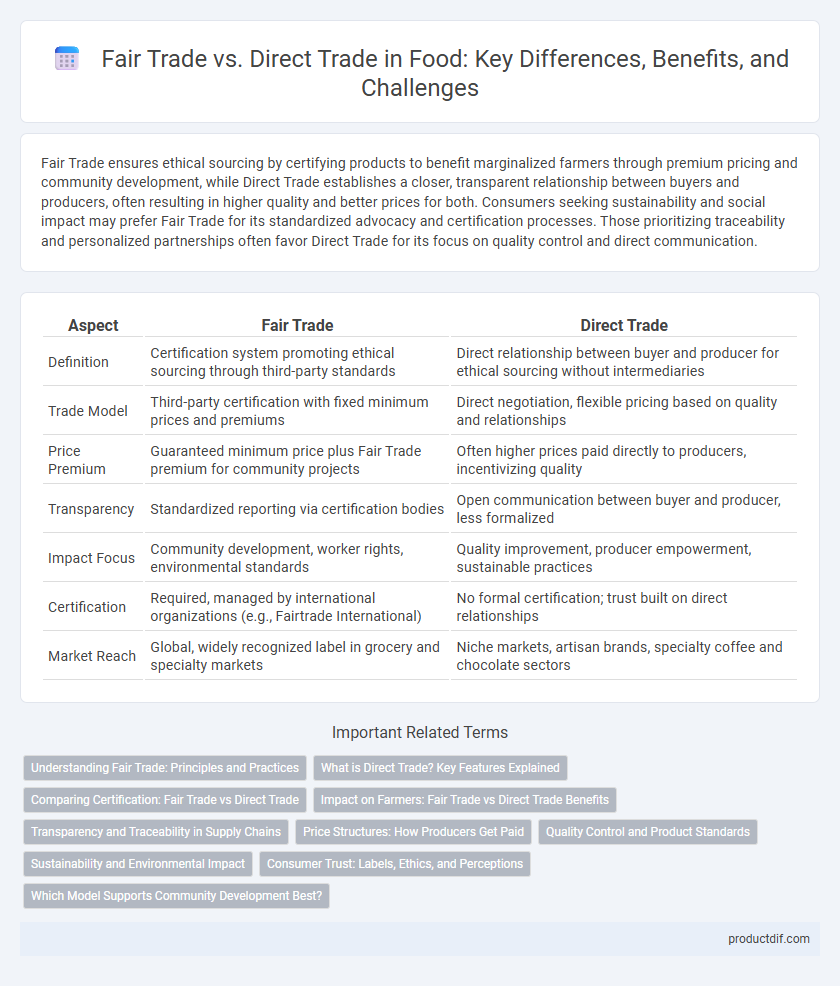Fair Trade ensures ethical sourcing by certifying products to benefit marginalized farmers through premium pricing and community development, while Direct Trade establishes a closer, transparent relationship between buyers and producers, often resulting in higher quality and better prices for both. Consumers seeking sustainability and social impact may prefer Fair Trade for its standardized advocacy and certification processes. Those prioritizing traceability and personalized partnerships often favor Direct Trade for its focus on quality control and direct communication.
Table of Comparison
| Aspect | Fair Trade | Direct Trade |
|---|---|---|
| Definition | Certification system promoting ethical sourcing through third-party standards | Direct relationship between buyer and producer for ethical sourcing without intermediaries |
| Trade Model | Third-party certification with fixed minimum prices and premiums | Direct negotiation, flexible pricing based on quality and relationships |
| Price Premium | Guaranteed minimum price plus Fair Trade premium for community projects | Often higher prices paid directly to producers, incentivizing quality |
| Transparency | Standardized reporting via certification bodies | Open communication between buyer and producer, less formalized |
| Impact Focus | Community development, worker rights, environmental standards | Quality improvement, producer empowerment, sustainable practices |
| Certification | Required, managed by international organizations (e.g., Fairtrade International) | No formal certification; trust built on direct relationships |
| Market Reach | Global, widely recognized label in grocery and specialty markets | Niche markets, artisan brands, specialty coffee and chocolate sectors |
Understanding Fair Trade: Principles and Practices
Fair Trade ensures equitable trading conditions, emphasizing fair wages, safe working environments, and sustainable livelihoods for farmers and workers in developing countries. It operates through certified cooperatives that meet social, economic, and environmental standards verified by organizations like Fairtrade International. This model supports community development, transparency, and long-term partnerships aimed at poverty reduction and ethical sourcing in the global food supply chain.
What is Direct Trade? Key Features Explained
Direct Trade is a sourcing model that builds transparent, direct relationships between coffee roasters and farmers, bypassing traditional intermediaries. It emphasizes quality control, higher premiums for producers, and mutual accountability to ensure ethical and sustainable practices. Key features include negotiated prices based on quality, regular farm visits, and direct communication, fostering trust and improving farmer livelihoods.
Comparing Certification: Fair Trade vs Direct Trade
Fair Trade certification involves third-party auditing to ensure compliance with social, environmental, and economic standards, emphasizing collective farm benefits and premium pricing for certified crops. Direct Trade relies on buyer-seller relationships with no standardized certification, allowing for tailored quality control and often higher payouts directly to farmers, though standards can vary widely. Fair Trade's transparent certification process provides consumer trust, whereas Direct Trade offers flexibility and potentially better incentives aligned with quality and sustainability.
Impact on Farmers: Fair Trade vs Direct Trade Benefits
Fair Trade ensures farmers receive minimum prices and community development premiums, promoting economic stability and social welfare. Direct Trade emphasizes transparent relationships and higher-quality products, allowing farmers to negotiate better prices and gain direct market access. Both models improve farmers' livelihoods, but Direct Trade often results in greater income by cutting out intermediaries and fostering personalized partnerships.
Transparency and Traceability in Supply Chains
Fair Trade emphasizes transparency by certifying producers and ensuring ethical labor practices, but often involves multiple intermediaries that can obscure full traceability. Direct Trade prioritizes traceability by fostering direct relationships between buyers and farmers, enabling detailed tracking of product origin and production methods. This approach enhances supply chain transparency and accountability, offering consumers clearer insight into the food's journey from farm to table.
Price Structures: How Producers Get Paid
Fair Trade establishes fixed minimum prices and premiums to ensure producers receive stable, fair compensation regardless of market fluctuations, promoting community development and sustainability. Direct Trade typically allows buyers to pay higher prices directly negotiated with producers, incentivizing quality and fostering closer relationships but without guaranteed price floors. Both models aim to improve producer income, with Fair Trade prioritizing price security and Direct Trade emphasizing personalized pricing linked to product excellence.
Quality Control and Product Standards
Fair Trade emphasizes strict adherence to internationally recognized product standards and certifications to ensure ethical sourcing and quality control throughout the supply chain. Direct Trade fosters closer relationships between buyers and producers, enabling more rigorous, personalized quality control tailored to specific product attributes and consumer preferences. Both approaches strive to enhance product quality, but Direct Trade often allows for greater flexibility and responsiveness in maintaining high standards.
Sustainability and Environmental Impact
Fair Trade certification emphasizes sustainability by ensuring ethical labor practices and environmental protections through third-party audits in coffee and cacao industries. Direct Trade models prioritize close relationships with farmers, allowing for customized sustainability practices that often exceed standard environmental requirements. Both systems aim to reduce carbon footprints and promote biodiversity, but Direct Trade tends to offer more flexibility in implementing innovative, farm-specific ecological improvements.
Consumer Trust: Labels, Ethics, and Perceptions
Consumer trust in Fair Trade and Direct Trade hinges on the transparency and credibility of their labels; Fair Trade certifications provide standardized ethical assurances, while Direct Trade emphasizes personal relationships and traceability. Ethical considerations influence perceptions, with Fair Trade often associated with community benefits and Direct Trade linked to quality and farmer empowerment. Clear communication of sourcing practices enhances consumer confidence and drives informed purchasing decisions in ethical food markets.
Which Model Supports Community Development Best?
Fair Trade emphasizes community development by guaranteeing fair prices, social premiums, and long-term partnerships that fund education, healthcare, and infrastructure projects in producer communities. Direct Trade fosters community growth through close relationships between buyers and farmers, promoting transparency, premium quality, and reinvestment in local farming practices and livelihoods. While Fair Trade provides structured community benefits, Direct Trade's personalized approach often leads to tailored support and sustainable local development.
Fair Trade vs Direct Trade Infographic

 productdif.com
productdif.com